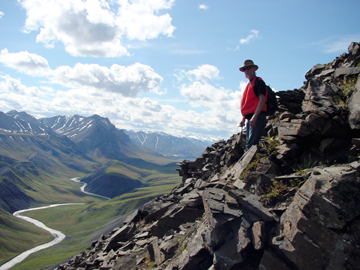 For close to
30 years, people have been working to build a natural gas pipeline from Alaska’s
North Slope to the lower 48 states. In October, Congress finally gave the go-ahead
by authorizing the construction of the pipeline. President Bush signed the bill
into law on Oct. 13.
For close to
30 years, people have been working to build a natural gas pipeline from Alaska’s
North Slope to the lower 48 states. In October, Congress finally gave the go-ahead
by authorizing the construction of the pipeline. President Bush signed the bill
into law on Oct. 13.Phil Nelson, a geologist at the U.S. Geological Survey in Denver, stands among sandstones that overlook the Atigun River in the Brooks Range foothills on Alaska’s North Slope, which has an estimated 35 trillion cubic feet of natural gas. Congress has now approved a pipeline project to transport the region’s natural gas to the lower 48 states. Photo courtesy of Dave Houseknecht.
Alaska’s North Slope is estimated to hold 35 trillion cubic feet of proved reserves and probably an additional 100 trillion cubic feet of undiscovered gas, says David Houseknecht of the U.S. Geological Survey. Right now, that gas is considered “stranded,” he says, because there is no way to get it to market.
That’s why Alaska’s congressional delegation in October called the pipeline bill’s passage “great news” for Alaskans and all Americans. “Upon completion, the Alaska natural gas pipeline will decrease our dependency on foreign gas and imports of liquefied natural gas, generate more than $40 billion in revenues for the federal government and create more than 400,000 jobs,” said Sen. Ted Stevens (R) in a statement.
Congress attached the pipeline authorization to the fiscal year 2005 military construction appropriations bill, which the House passed on Oct. 9, and the Senate passed on Oct. 11. The bill not only authorizes the construction of the pipeline but also provides provisions key to getting oil and gas companies to invest in the $20 billion project, said Sen. Lisa Murkowski (R) in a statement.
The bill accelerates pipeline construction and requires an expedited permitting and judicial review process. It also includes a loan guarantee designed to reduce investors’ concerns about the pipeline not being completed if gas prices fall significantly: The federal government will repay the investors 80 percent of the cost of the first $18 billion spent, if the project is not finished. The corporate tax bill, also passed in October, provides additional incentives for the project that could save investing companies $445 million over the next decade.
Sen. Murkowski says that these tax incentives and the loan guarantee are the key pieces that will allow companies to proceed with the project. “The puzzle isn’t finished, but the federal outline is now done,” she said in a statement.
“Passage of these provisions brings us one important step closer to the next phase of permitting and engineering,” says Dave MacDowell, a spokesman for BP Alaska. But U.S. federal legislation is just “one leg of a four-legged stool,” MacDowell says. Before the gas owners will enter the next phase, other essential elements need to be in place, he says, including a clear regulatory process in Canada (through which two-thirds of the pipeline would pass), continuing cost reduction plans using new technologies, and a “clear and durable fiscal contract” with the state of Alaska.
To that end, Republican Gov. Frank Murkowski announced in late October that the state would be sending oil companies, including BP, ConocoPhillips and ExxonMobil, a proposal to share ownership of the pipeline between the companies and the state — thus lowering the cost and risk for the companies. Once the companies and the governor’s office agree to terms, the state legislature will have final approval.
Although an exact route has yet to be chosen for the pipeline, it would likely follow the existing oil Trans-Alaska Pipeline System at least part of the way through the state, says Rhea DoBosh with the Joint Pipeline Office in Anchorage, a state and federal coalition of agencies. Virtually all of the pipeline would be underground and remotely operated, she says. While the government and companies have been negotiating, the Joint Pipeline Office has been working on right-of-way permits for the pipeline to be laid. “Right now, we’re making sure that the climate is conducive to progress,” DoBosh says, so that when a decision is made to go forward, they’ll be ready to build.
The reality, MacDowell says, is that even once the engineering phase begins on the pipeline, it will take close to 10 years before any gas can actually begin flowing. Thus, the building of the pipeline and bringing this “stranded” gas to market “will definitely help our energy situation, but not immediately,” says Bob Moran with the American Petroleum Institute in Washington, D.C. “It is a good first step,” he says, but “we also need conservation and efficiency, to diversify our energy supply sources and to increase domestic natural gas production.”

